#Pictish Cross
Text


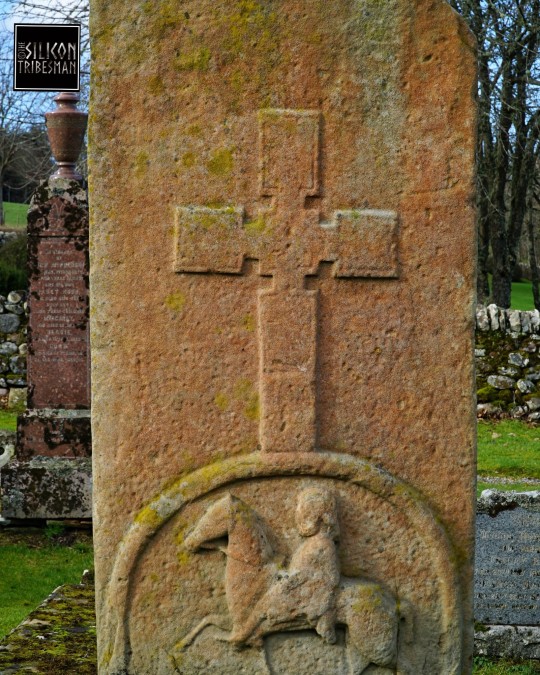
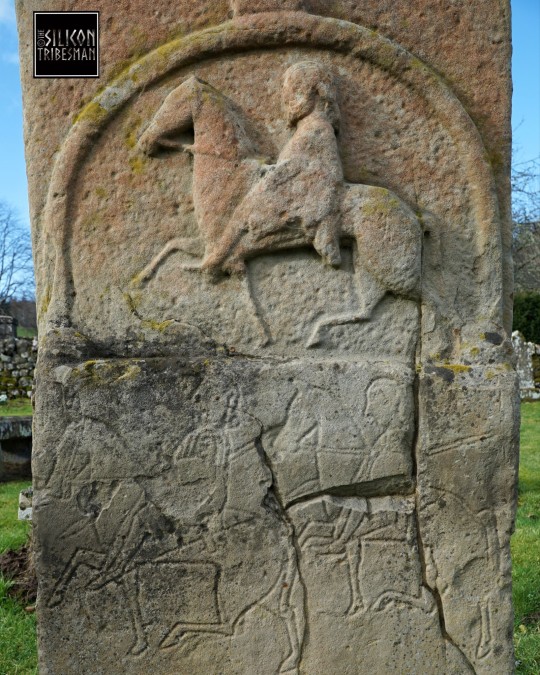



Edderton Pictish Cross Slab, Edderton, Scotland
#pict#picts#Pictish Cross#Pictish Symbol Stone#Pictish Design#Pictish art#Scotland#ancient cultures#ancient craft#ancient design#ancient living#archaeology#stone carving
85 notes
·
View notes
Text

Pictish stone wolves !
20 notes
·
View notes
Text
The Kebbuck Stone, Ardersier: A Lost Pictish Symbol Stone?
The Kebbuck Stone, Ardersier: A Lost Pictish Symbol Stone?
by Fiona Campbell-Howes
This is the Kebbuck Stone, a relief-carved cross slab dated to the 8th or 9th century, which today sits in the back garden of a cottage near Ardersier.
Location of the Kebbuck Stone in Nairnshire
It’s usually overlooked in the corpus of early medieval (“Pictish”) stone sculpture because the carvings have almost completely worn away and the surface of the stone is…

View On WordPress
#Ardersier#Becoming an Early Medievalist#early medieval archaeology#George Bain#Kebbuck Stone#pictish cross slab#pictish symbol stone#Rodney&039;s Stone#Simon Taylor#Sueno&039;s Stone
0 notes
Text
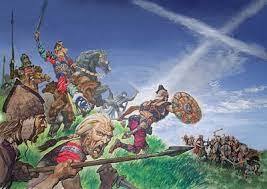

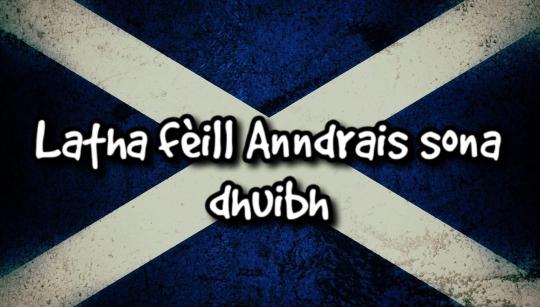
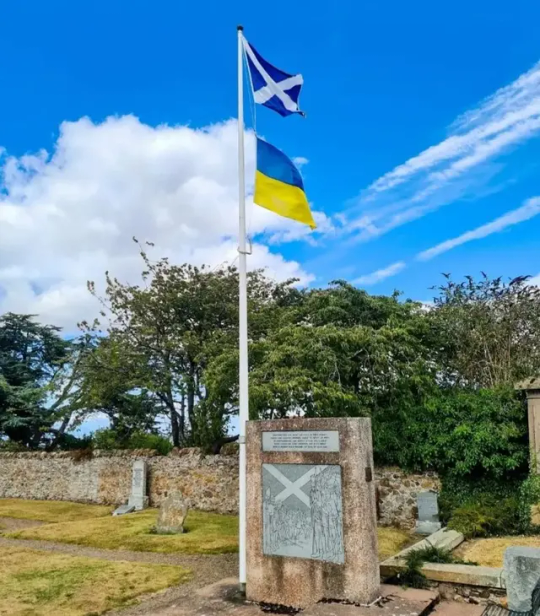

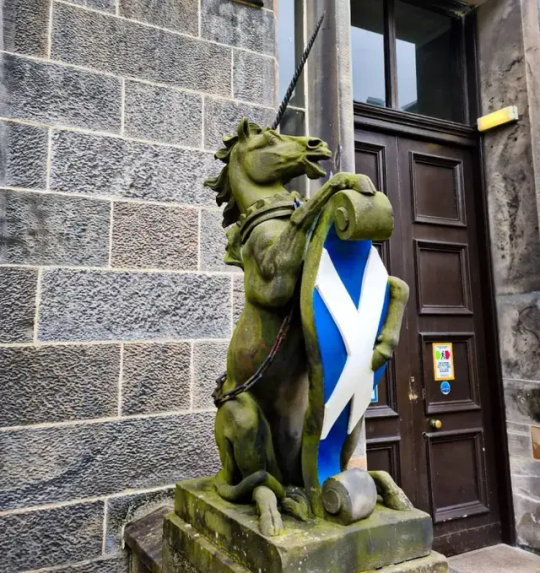
Happy St Andrews Day.
As part of our Patron Saint’s Feast Day the Scottish Saltire is proudly flown and many people add it to their posts on social media to celebrate the day, but how did Scotland adopt the saltire?
There is no actual date, or in fact nothing in our written history of the time, but legend has it that in AD 832 the king of the Picts, ‘Aengus MacFergus’, ( Anglified to Angus but some stories say Hungus) with the support of 'Scots’ from Dalriada, won a great battle against King Athelstane of the Northumbrians. The site of the legendary battle became known as Athelstaneford in present-day East Lothian.
St Andrew visited the Pictish leader in a dream before the battle and told him that victory would be won. When the battle itself was raging, a miraculous vision of the St Andrew’s Cross was seen shining in the sky, giving a boost to the morale and fighting spirit of his warriors. The result was a victory over the Saxons, and the death of Athelstan. Thus, after this victory, according to the tradition, the Saltire or St Andrew’s Cross became the flag of Scotland, and St Andrew the national patron saint.
While there is no written reference to the battle in Scotland from the period it was said to have taken place, this is not surprising, as it was a time for which we have little or no documentation for anything. The earliest written mention of the Battle of Athelstaneford in Scottish history comes from years later in the newspapers of the day, if you follow my posts then you know I dip into these “Chronicles from time to time, the first one to mention Athelstaneford is the Scotichronicon, written by the Scottish historian Walter Bower.
The Scotichronicon has been described by some Scottish historians as a valuable source of historical information, especially for the times that were recent to him or within his own memory. But he also wrote about earlier times, and this included the battle at Athelstaneford.
Bower’s account includes the scene where Aengus MacFergus is visited by St Andrew in a dream before the battle. He was told that the cross of Christ would be carried before him by an angel, there was no mention of a St Andrew’s Cross in the sky in this version. It was in later accounts, from the 16th centuries onwards, that we have the description of an image of St Andrew’s Cross shining in the sky
Bower was writing in the early 1400s. The bitter and bloody struggle to retain Scotland’s independence was not just a recent memory but also a current reality for him. Parts of Scotland were still occupied by England, and Bower had been involved in raising the money to release Scotland’s king, James I, from English captivity.
Also, Scotland’s early historical records and documents had been deliberately destroyed during the invasion by the English king Edward I. This was done in part as an attempt to remove historical evidence that Scotland had been an independent kingdom. The idea was simple: take away a nation’s history and you strip it of its identity and justification for its independent existence. The theft of the Stone of Destiny was part of this process, the Black Rood which was believed to contain a piece of the Cross Jesus was crucified on was also removed, I have covered both these in previous posts.
Part of Bower’s motivation in writing his Scotichronicon was to help restore this stolen history. He was a scholar and a man of the church. In his time, the figure of St Andrew had become a prominent presence in Scottish society.
The greatest church building in the land during his time was the Cathedral of St Andrew, which housed relics of St Andrew himself. It had taken over a hundred years to build and wasn’t formally consecrated until 1318, just four years after Bannockburn. The ceremony of course included Robert the Bruce and at it thanks was given to St Andrew for Scotland’s victory.
Less than 100 years after this, in 1413, the University of St Andrews was established and Walter Bower was one of its first students. By this time, the Cathedral of St Andrew was a place of pilgrimage, with thousands travelling there to venerate the saint’s relics. A pilgrimage route from the south took in the shrine of Our Lady at Whitekirk, not far from the site of the battle, and many pilgrims took a ferry across the Firth from North Berwick, where the ruins and remains of the old St Andrew’s Kirk can still be seen close to the Scottish Seabird Centre.
So as he sat down to write his history of earlier times, he was able to trace this connection to St Andrew, using the limited earlier written accounts, such as those of earlier Chronicler I’ve mentioned before, John Fordun, who lived in the 1300s. While Fordun doesn’t specifically mention the location of Athelstaneford, he records a battle which took place between the Picts led by Aengus and a force from the south led by Athelstan, and said the location of the battle was about two miles from Haddington. The account of St Andrew appearing in a dream to Aengus is also described by Fordun.
This creates a powerful link to the development of the written version of the story. Let’s remember Bower came from what is now East Lothian. Let us also remember that people in the early centuries stored and passed on much of their historical knowledge not in the written word but in memory and handed down oral traditions. People told stories, remembered them and told them to the next generation. Undeniably, some details would be forgotten or changed over time, but the bones of the story would be handed down. And that would include reference to locations of significant events in the local landscape.
Bower will have had access to this rich oral tradition of local stories based on handed-down collective memories of past events, which is perhaps why he was able to name the location. The later writers who added to the story of the battle will likewise have found new sources in the oral tradition to add to the narrative. Even in the 19th century, cartographers mapping the area were able to identify locations traditionally associated with the battle from local people who were custodians of ancestral memory.
This is how the story of the Battle of Athelstaneford and its connection with St Andrew and the Saltire has evolved.
The village is home to the National Flag Heritage Centre which occupies a lectern doocot built in 1583 and rebuilt in 1996. It is at the back of the village church. Today the village is surrounded by farmland and has little in the way of amenities. Tourists can follow the "Saltire Trail", a road route which passes by various local landmarks and places of historical interest.
Athelstaneford Parish Kirk has a connection with the subject of my post last week, author Nigel Tranter, who was a prominent supporter of the Scottish Flag Trust. He married in the church, and in April 2008 a permanent exhibition of his memorabilia was mounted in the north transept of the church. Items include a copy of Nigel Tranter's old typewriter, a collection of manuscripts and books, and other personal items. The display was previously at Lennoxlove House, and prior to that at Abbotsford House, the home of Sir Walter Scott.
26 notes
·
View notes
Text
Celtic/Pictish Knotwork Part 1/?
In sitting down to explain how I managed to design a knotwork border for a previous embroidery project, I found I could not, because I didn't quite understand it myself, so here I'm going to lay down the very basics of Celtic/Pictish knotwork that I've learned from various sources.
First we'll do a two by two knot, and then a three by two knot.
SO. TO BEGIN. You make a bunch of grids! I did it in different colors so you can see them! BEHOLD.

Your PRIMARY GRID! 2 spaces by two spaces.
Next, you find the center of your blue boxes and put a nice pink dot in them. Connect the dots to make your SECONDARY GRID.
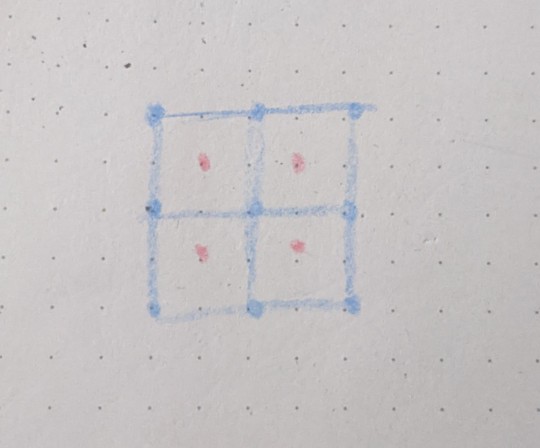

A single link. Very simple. Here it comes. Put a green X on each place where the PRIMARY grid crosses the SECONDARY grid. This gives you your TERTIARY GRID.
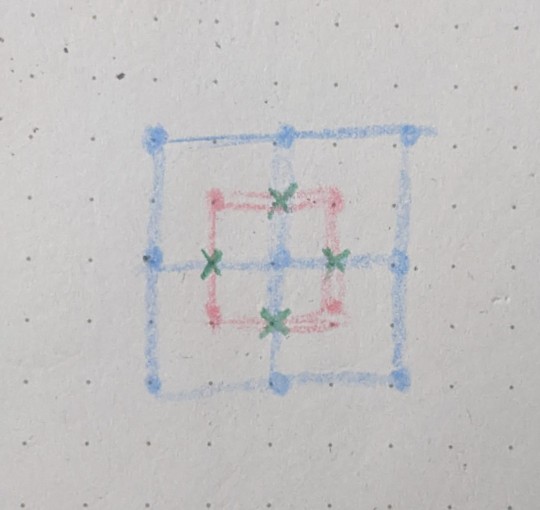
Now to draw the links that make the knot. Start in the upper left corner and head right. Imagine that the pink dots have gravity, but the green X's have more. Essentially, you will travel through the green X's until you hit a blue wall. Then you swing to the right around the closest pink dot and through the next green X. Then you will travel straight through the next green X's until you hit another blue wall. (This will be clearer in the second example, but I recommend doing this one first just to get the feel of it.) Proceed in this manner until you have filled in the grid. This one takes no time at all, but it can be multiplied many times and the same formula works.

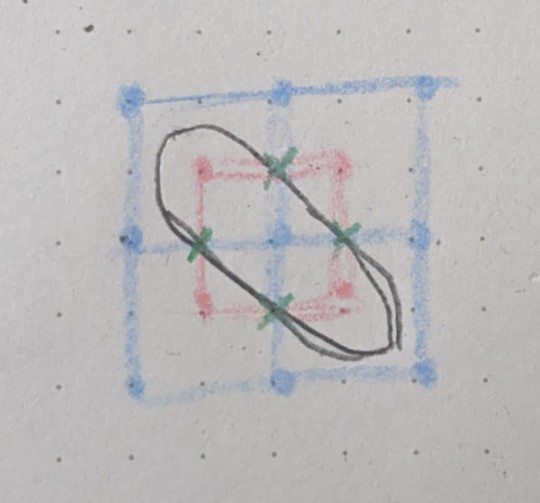
Are there still green X's? Then you have another line to do!


Now here comes the magic. Go back to your tertiary grid. Decide left or right, it doesn't matter--I chose down to the right--and draw hash marks in that direction on the top green X. Go down to the next row of green X's (2 of them this time) and draw hash marks in the opposite direction. Go down to the last row, and again reverse the hashmarks to the original orientation. Then simply fill in your line, following the over/under hashmark guide.


Erase, and you have your simple knot.

3x2 grid now. This will result in one continuous line that snakes over and under itself. Grid layout:


Start at the top, and follow your lines through, swinging around pink dots at the periphery.

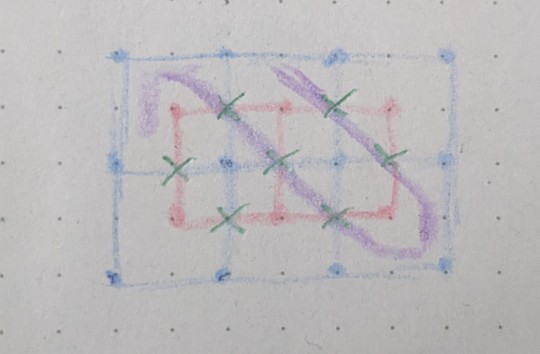
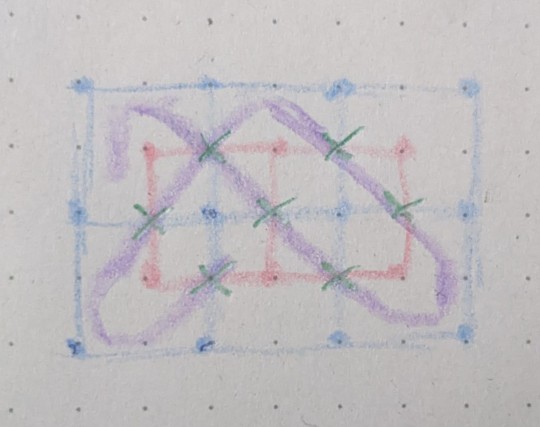

And like magic it sort of just...loops around. Connect it and put in your hashmarks--two, three, and two this time--and follow the guide.
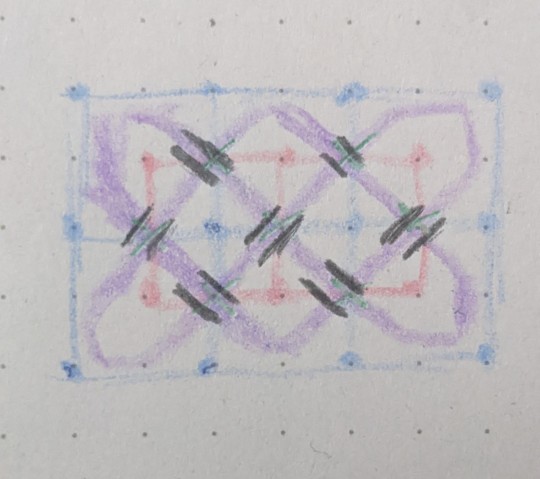

Ink and erase to make it pretty - I didn't really bother making this nice and neat, but you get the idea.

Use a straight edge to make it look good lol, you can tell I did this freehand on my living room floor.
These rules eventually lead to stuff like this:

...and worse! Algorithmic! My favorite thing to do on long winter nights is set up a big one-line knot and then make my husband watch me connect it after he's had too many edibles. Then he accuses me of being a witch and it's a whole thing, good times. TBC maybe.
137 notes
·
View notes
Text
8th June
St Columba’s Day
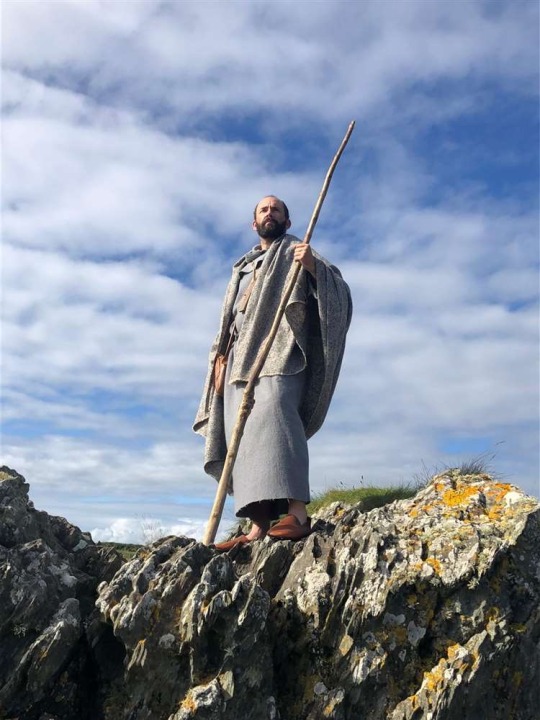
Colmcille (St Columba) on High. Source: BBC Alba and The Northern Scot website
Today is St Columba’s Day. Despite his saintly title “The Dove of Peace” (Colmcille in Gaelic), Columba had a somewhat violent temperament. A dispute over the authorship of a Psalter with a fellow cleric in his native Ireland led to an actual battle between their respective bands of followers, until the Irish Church intervened and sent Columba off to Scotland to convert the still pagan Picts to Christianity. But bad temper and violence accompanied even his missionary work. Slipping on a flounder one day, Columba is said to have cursed the unfortunate fish, leading to its lopsided appearance. He also dealt with a lecherous Pictish noble by “smiting him with an Angel”. Whereas his victim was suitably stunned, the fate of the angel projectile is not known.
Columba’s most famous exploit was rescuing his followers from the Loch Ness Monster, who in an early fifth century appearance, reared threateningly above two of the saint’s disciplines who were attempting to cross the loch in a small boat. Columba ordered the creature not to harm the men and it slipped away under the surface of the lake and has not harmed anyone since. Columba was a highly successful missionary and based himself on the island of Iona where he developed an almost cult like status.
Apparently Columba wore the flower of St John’s Wort to ward off evil. Apparently it still works.
17 notes
·
View notes
Photo
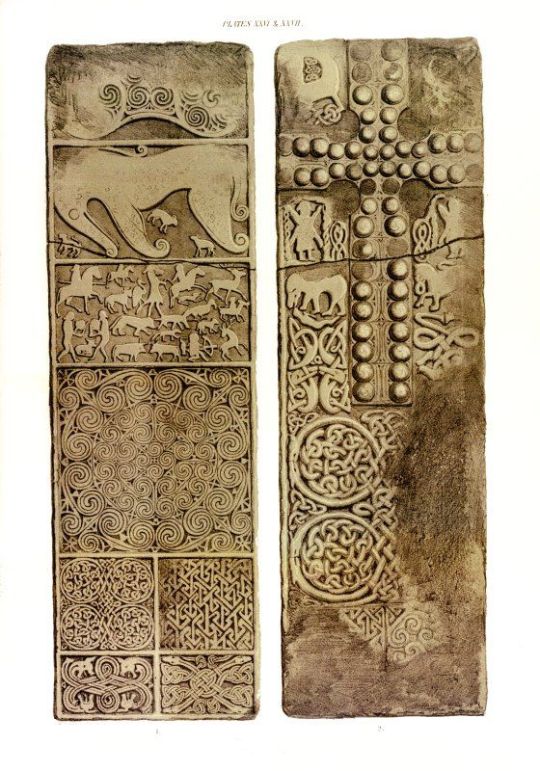
The Clach a' Charaidh or Shandwick Stone
The Clach a' Charaidh or Shandwick Stone is a Class II Pictish stone located near Shandwick on the Tarbat peninsula in Easter Ross, Scotland. The cross faces the seaward side and the secular scene faces inland. The latter contains six panels, the first (from top to bottom) being a standard Pictish double-disc, the second being a Pictish beast and the third being a possible hunting scene, with warriors depicted alongside an eagle, a boar and various other creatures; the bottom three panels consist of woven patterns.
The stone is now encased in a glass cover room. The Gaelic name Clach a’ Charaidh means ‘stone of the grave-plots’: a burial ground here was recorded in 1889 as last used during the cholera epidemic of 1832 and ploughed under about 1885.
text abridged from wikipedia
101 notes
·
View notes
Photo

On this day, August 22, 565 St Columba reports seeing monster in Loch Ness. The first recorded sighting of the Loch Ness Monster.
Columba or Colmcille (7 December 521 – 9 June 597 AD) was an Irish abbot and missionary evangelist credited with spreading Christianity in what is today Scotland at the start of the Hiberno-Scottish mission. He founded the important abbey on Iona, which became a dominant religious and political institution in the region for centuries. He is the patron saint of Derry. He was highly regarded by both the Gaels of Dál Riata and the Picts, and is remembered today as a Catholic saint and one of the Twelve Apostles of Ireland. Columba studied under some of Ireland's most prominent church figures and founded several monasteries in the country. Around 563 AD he and his twelve companions crossed to Dunaverty near Southend, Argyll, in Kintyre before settling in Iona in Scotland, then part of the Ulster kingdom of Dál Riata, where they founded a new abbey as a base for spreading Celtic Christianity among the pagan Northern Pictish kingdoms. He remained active in Irish politics, though he spent most of the remainder of his life in Scotland. Three surviving early medieval Latin hymns may be attributed to him.
As for the “monster”, in the 1960s several British universities launched sonar expeditions to the lake. Nothing conclusive was found, but in each expedition the sonar operators detected some type of large, moving underwater objects. In 1975, another expedition combined sonar and underwater photography in Loch Ness. A photo resulted that, after enhancement, appeared to show what vaguely resembled the giant flipper of an aquatic animal.Further sonar expeditions in the 1980s and 1990s resulted in more inconclusive readings.
57 notes
·
View notes
Text
trying to explain to my pet pictish farmer the constant worry of unknown cross-platform integrations that could be doing things like posting updates to an instagram account i forgot i had but that all my family follows every time i put my red dead online character in a gay jacket, but he caught wind of a box of salt in my pantry and only half-listens while trying to sneak handfuls into his gross leathers
10 notes
·
View notes
Text

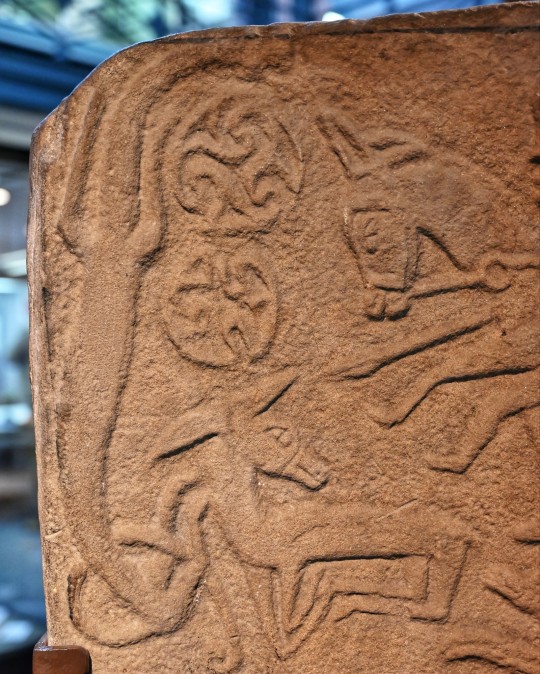
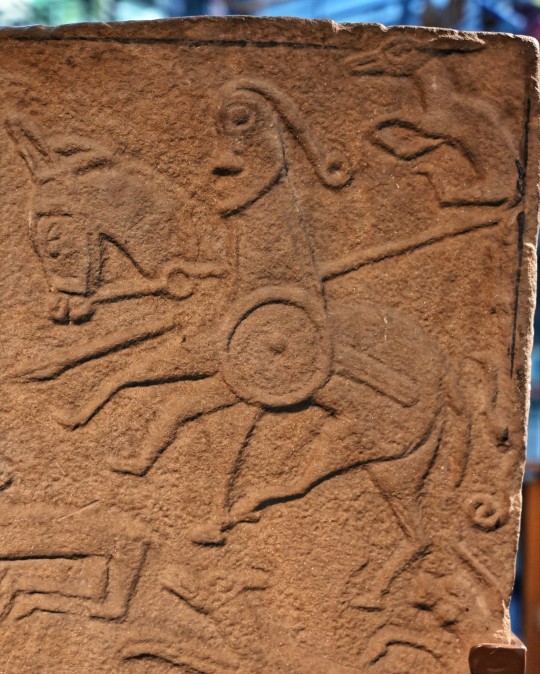

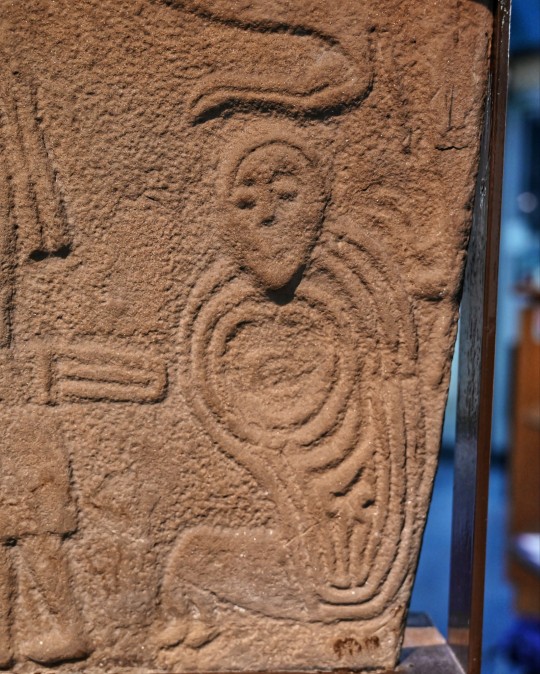
Inchbrayock 1- The Inchbrayock or Samson Pictish Symbol Stone, Montrose Museum, Montrose, Angus
This side - the back - shows a hunter on horseback, armed with spear, sword and shield, chasing a deer, aided by his deer hound. He is probably quite well off, judging by his neat beard and hair. He may well represent the man for whom the stone was made. Below is Samson smiting a Philistine with the jawbone of an ass. Samson is dressed as a Celt and spot the obvious mistake with the teeth on the wrong side of the jawbone.
Three other beasts are also present, and a kneeling deer, which is very similar to one on the Aberlemno Churchyard Stone. The figure in the right corner may be a pregnant lady, perhaps Eve, while the two discs with spirals are very similar to the earlier Pictish double-disc symbol.
#Pictish#pict#Pictish art#symbols#early cross#Pictish cross#archaeology#ancient craft#ancient living#ancient cultures#Scotland#Pictish Stone#early religion#ancient beliefs
129 notes
·
View notes
Text

Pictish kelpie pattern! Would it be worth selling these patterns? (Like for 3 bucks on Etsy?)
17 notes
·
View notes
Note
What would you recommend to an aspiring Celticist for a tattoo? My sister wants to get matching Celtic tattoos, and while I’ve started to study Celtic mythology, I’m definitely no expert lol. I know a lot of symbols you’d find on the internet are bullshit, and a lot of the real ones have a ton of baggage associated with them (literally the first thing I told my sis when she brought this up was that we had to be careful & do our research when picking these out bcs the nazis looove that shit). But what would you recommend? Is there anything we should definitely steer clear of? Thanks!!
I'm going to either be really helpful or really non-helpful: A lot of this will depend on you and your sister.
Like, for me, when I've thought of Celtic-inspired tattoos, they're always things that are very personal to me. Like, for example, Bres' name in Ogham on my wrist, since it's always been him and me surviving this together, the Children of Lir, because that's a personal good luck symbol (yes, the most notoriously UNLUCKY story in the Mythological Cycle -- I have a Children of Lir necklace that I wore when I was giving my Capstone Presentation in my undergrad, and I've worn it to every talk I've ever given, even to my interview with my current program), an image of an owl (for Blodeuedd) or something like the Pictish Beast, since I love marine animals and waterhorses in the folkloric tradition. So, I'd look at what appeals to you and your sister, your relationship, shared interests, etc.
There's only one Celtic image that's formally been designated as being a potential white supremacist symbol by the anti-defamation league, and that is the Celtic Cross.
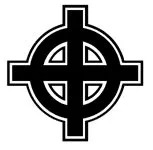
This is the image that most white supremacists will use, you'll notice that it has very short ends.
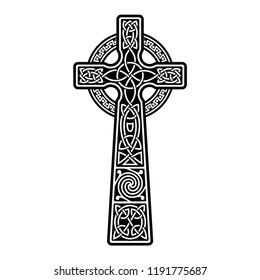
This is the more traditional Celtic cross -- you'll see these in just about every single tourist shop in Ireland, as well as in cemeteries. I'd be lying if I said that I don't still feel a bit of a jolt whenever I see the regular one in a tattoo; it shouldn't, because it's an image that is emblematic of Irishness and Irish heritage. And I don't feel that way about, say, a necklace, but a tattoo is much more different to me. It's permanent, it's...intimate. So I would suggest staying away from either version, even though the one at the bottom is NOT the one that has been appropriated by white supremacists.
I also tend to be distrustful of people who have like....mixed Celtic and Nordic symbols. Like, the Vikings did settle in Ireland, some Irish words are based in Norse terms, Cork, Dublin, and Waterford are Viking cities originally, there are a lot of folktales in common between Ireland and Norway, there are historic links there. That being said, anyone who treats them as being interchangeable (the term "Nordic-Celtic" makes me shudder whenever I see it in an organization's name and, no, I do not give a single fuck if you say that you aren't THAT kind of Nordic Celtic) raises my fight or flight response. Like, they're both part of this implicit idea of White Warrior Male Culture. But that's not a problem unless you're getting multiple tattoos. (Tbh, if I see a random Celtic knot on someone...I might think 'white supremacist' or I might think 'Irish American', it depends on everything else.)
...also a Celtic knot world tree symbol. Not because they're white supremacist, but because it isn't really based strongly in the Irish tradition.
Quite a few people in the field will get ogham tattoos, especially in Modern or Old Irish, possibly using a word or phrase that's important to them. One friend of mine has one that is a phrase that is related to their health problems and reflects their fortitude. You might get an image based on a particular story (I might actually choose the Children of Lir, just because, everything else about it aside...it does contain a really strong sibling relationship.)
Basically: Why do you want a Celtic-inspired tattoo (from any of the various Celtic cultures?) What are you interested in? What speaks to you as people?
12 notes
·
View notes
Text

I am off to Rhodes for a week on Friday, so might not be able to post as often as I usually do. I will be taking my laptop so there will be some anniversary posts, maybe not as many as usual.Got a busy day tomorrow in preparation, and a friends birthday, so may not have so many posts as well.
There is one tribute post that I have done a little work on so far, other than that who knows. Friday I will see how things go at the Airport as we await the flight.
Greece and Scotland have some connections, some tenuous, some contentious, but all relevant.
Ancient Greece has been a source of great fascination for centuries. Scotland’s connection to the ancient civilisation is visible in Scotland’s ancient name, “Caledonia”, which may have come from Caledon, an ancient city-state in Ancient Greece which experienced migrations to the place that we now call Scotland.
History supports Caledon as the name given to Scotland by the Romans, which could have something to do with the Greek settlers living in the country at the time.
The National museum of Scotland holds around 3,000 permanent artefacts which relate to ancient Greece, These artefacts might not be as famous as the main ones in the British museum, The Elgin Marbles which were "acquired" by oor ain Lord Elgin in Athens, Greece between 1801 and 1805. Elgin sold them to the museum in 1815. Greece has disputed the British Museum’s ownership of the sculptures, maintaining that Lord Elgin removed them illegally while the country was under Turkish occupation as part of the Ottoman Empire. I'm all for repatriating artefacts stolen, however tenuously you want to say they weren't, and think they should be returned to there rightful place on the Parthenon.
The case for Scotland’s link to ancient Greece may displease some Scots, as it has recently been reported that Scottish tartan may have actually first been weaved by the ancient Greeks, and it has long been known that a haggis-type dish was eaten before Scotland was any more than a rugged isle.
Of course we also share a patron saint, the Apostle, Andrew went to Greece where he was told to stop spreading the teachings of Jesus by the governor Aegeas as he still believed in the Roman gods. When he refused, Andrew was sentenced to death by crucifixion in the city of Patras.
St Andrew has been celebrated in Scotland for over one thousand years, with feasts being held in his honour as far back as the year 1000 AD. However, it wasn't until 1320, when Scotland's independence was declared with the signing of The Declaration of Arbroath, that he officially became Scotland's patron saint.
There are two stories about how his remains came to their final resting place in St Andrews in Scotland.
One fairly probable explanation is that the bones were brought to St Andrews in 732 AD by Acca, Bishop of Hexham who was a venerator of Saint Andrew.
The other story suggest that the Greek monk who kept St Andrew’s relics in Patras was told in a vision to set aside some of St Andrew’s relics in hide until further instruction.
In the following days the emperor removed the remaining parts of St Andrew’s body to Constantinople (now an area in Turkey).
Then the angel came again in a vision to the Greek monk Rule and told him to take the bones west on a ship and wherever they were shipwrecked he should lay the foundations of a church.
The ship was driven ashore on the headland of Muckross in Fife into the village of Kilrymont, which would later become St Andrew’s.
At the same time as Rule arrived in Scotland, legend has it that St Andrew appeared to the Pictish King, Angus when he was preparing for battle promising victory.
When the King’s army was victorious he dedicated St Regulus Church to St Andrew and to God.
In the dream when St Andrew appeared to the King, he saw St Andrew’s Saltire cross in the blue sky, Angus vowed that if, with the saint’s help, he gained the victory, then Andrew would thereafter be the patron saint of Scotland. The Scots did win, and the Saltire became the flag of Scotland.
The second flag in the gif is that of Rhodes.
47 notes
·
View notes
Text

Chapter 1
Chapter 2
Chapter 3
4. The Lightning Wasteland (Spanish version here)
@engportevents
The sky was pink and the mountains orange, and when the wind passed coming from a black void, it became an iridescent blue; tall grasslands up to the waist of an adult, but clearly untouched by any human. Virgin and natural.
It was a narrow place with its limits, since its white edges fell violently vertically towards nothingness, from which seemed to come a noise similar to the waves of the sea that crashed against white cliffs; even whiter than those that existed in the Earth dimension.
It was like a primitive projection of the same soil they inhabited and had left, to cross here. The directions were the same, the geographical forms too; it changed the logic of time and physics, but it made everything quite recognizable. Especially since in that place the connections were tangible; and Arthur was being pulled as if by a very long invisible umbilical cord, happy to return to his womb.
“Come, get up.”
There was no need to move the mouth the way they do in the mortal realm. Their thoughts were more powerful and it was the true way of communication on that side.
"Where are we?"
Gabriel stood up and noticed his nakedness, like that of his partner. The only difference between their appearances in the mortal world was that their eyes seemed to emanate light from within, and their fibers became a little more visible, revealing their skin. In addition, the blonde had blue Pictish markings on his body, in the form of complex drawings that had already lost their meaning over time.
"On the border of the Emerald Forest," said Arthur, pointing north. "Beyond those hills begins Fairyland."
Gabriel turned on his heel, confused.
“Is there more than the forest on the island? You said that all this was your continent.”
"Of course there's more, don't you remember?"
England pointed to the west, and among the natural fog of the area, which seemed to be the gateway to the human world, a very distant structure could be seen, in the shape of several superimposed towers.
"The Great Gray Castle" whispered Portugal, looking towards said direction "Where all the European kingdoms were born"
Arthur then pointed south, where there seemed to be other intersecting mountains farther away.
The hills, which seemed to almost be floating by themselves, had a huge bush with kilometer-long roots, which covered all the space that could be seen. It was not very tall but it was voluminous in leaves; bone-colored, as if petrified. But each part of its branches were covered in flowers, loaded with small cream-colored petals, which fell off like drops and danced in the air that passed them, in large numbers. And its branches, circular and entangled in themselves, protected the small fruits with sharp and long thorns along their entire length.
“The Holy Hawthorn” whispered Portugal, taking a few steps forward. “The last drop of light of Uriel, my godfather. It’s..."
"The Lightning Wasteland."
Evoking that name changed the landscape. The sky turned green and the winds blew in the direction of the floating islet, between the narrow land they stood on and what seemed to be the beginning of Europe, between the Iberian zone and Belgium.
"This..." Port took a few more steps, astonished "I thought it had disappeared."
"Why would it, dear?" Arthur walked over and stood next to him. "Actually, they’re relieved that you remember now."
"How is it still there? I know what you had to do to create it.”
“I did what was necessary. Even though I was very young, it was one of the brightest ideas I had in my life.”
"Also the most irrational..." replied the brunette, looking at him out of the corner of his eye, and the blonde puffed out his chest, with that big smile that victors emanated before their victories.
“That is precisely why I am proud of it. Their livelihood is still alive." Bright eyes looking at the others, "I tore out a piece of the Great Gray Castle to knead the earth, and plant its thorny seed to hold firm forever, individualized from all else."
"You almost disintegrated yourself in the audacity."
"It was worth it. It’s still here, precisely, because it was built with my love. A love that has never ceased." Gabriel suddenly turned to better see him "It is the reason why it continues to exist. Because I can lie about anything to the universe and the universe will believe me; but I never stopped loving you, Gabriel Dos Anjos, never."
“Arthur...”
He wanted to kiss him, on an impulse of his human rationality. But, they were nothing there, and everything. And so...
“We can’t be here, at this deep level” recalled Portugal, coming out of his own emotion. “We are the main form; and if we don't move, the other facets will start closing in on us.”
"Are you afraid of that?" England looked at him curiously, and the other rolled his eyes.
"I’m not afraid. But they can't all be stacked in the same place; they’ll disturb us.”
"It's true," the blonde conceded. “That is why we must go quickly to the Lighting Wasteland”
"But... how will we do it?" The Lusitanian looked forward again "It seems to be floating in the mid air."
"It's floating, yes, like a boat in the ocean" England smiled "I did it that way on purpose. It can only be accessed in one way: flying"
"Flying?" Gabriel looked at him suddenly "We can't fly!"
"I can’t, but you can."
Portugal stopped, a great pain in his temple made him shake his head with concern. He recognized the feeling; its other forms, the facets throughout its history and centuries, that made it up and had once been the main body of the country's vessel, were drawing closer, drawn like moths to the light. And for all of them to get out of their place and get closer was not the idyllic state that a Nation could have as such; above all, considering that he needed coherence so that his people were in the same place from which they left and to which they returned in their homes.
"We have to go, now." the man said worriedly. The blonde then reached for his ear, scratching it annoyed.
"Yes, they’re coming" he sighed tiredly and somewhat indifferently. “Surely the Pirate will want to know how to navigate the Empty Sea and fail… again.”
“How am I supposed to fly!? I don't know how to fly." The brunette looked at him desperately, holding his hair that fluttered in the wind.
"Not with that body, of course."
Gabriel paused for a moment, until he realized what he was suggesting.
"You must be kidding, Artinho."
"Of course not! Here everything is possible. You only have to think of your original form; as if you imagined it on the human plane” he made a gesture. "I assure you that you will succeed."
"But-!"
Louder noises began to mobilize the meadow hills behind them. Steps of various types; sighs, noises, groans, screams and laughter.
"Here they come, and they are deploying amongst themselves," the blonde deduced. "Maybe the more solid ones will reach us, I don't know" he scratched his chin. “I lost the motivation to come and see them.”
“Arthur!I can’t concentrate enough to do this! I haven't done it in hundreds of years."
“Think fast, marido” he squinted, “Or this will become a problem in a few minutes.”
"I-!"
The noise grew shriller, and the sky turned purple, beginning to thunder without a storm.
“Caralho, Arthur! You- you’re having fun with this, aren’t you?”
"I know you can do it! It's like taking a bicycle again after a lifetime without riding on one; muscle memory, the body remembers right away.”
The noise became annoying alongside the flashes in the sky, which looked like horizontal lightning.
"That's a stupid comparison!" raised his voice.
“Oh Arthur~ Where are you, you bourgeois rat? I have a gift for you.”
“I also want some…”
Behind them, two figures began to take shape among the wind-swaying grass. They were copies of them but dressed in extravagant ways, looking at them heavily.
“What are you doing here, modern forms? You’re far from home.”
“Perhaps they want to lend us the continent for a while. It's been a long time since we crossed the Bridge.”
The newcomers laughed together in a metallic voice, as if canned somewhere. As they approached, one drew a long golden scimitar, the other two silver and emerald pistols. They walked with a circular gait, swaying their hips as if they were dizzy, but it was the forging of their feet, raised in the swaying of the ships that they’d sailed at sea.
"How are you, Tiger of the Seven Seas?" Arthur turned to him calmly, "You’re active today."
"I won't waste an opportunity like this, Sir Arthur Kirkland." the pirate captain whispered, holding up his wide-brimmed black hat, while its feathers flew along with his red jacket in the wind.
"That much is clear, and you came with the Golden Ottoman Gypsy Thief" he greeted the other, who gave him a half smile.
"I’m the best navigator in the entire Dream World, cari," the brunette buccaneer answered. “Finding you was child's play.”
"I know. And you know as well as I do that it’s not prudent for you to stray from your plains or your seas, gentlemen."
“Nor you from yours, modern form... for that reason, we came to take advantage of your absence, like the good criminals that we are.”
As they got closer, Gabriel noticed that Arthur was looking at them calmly, facing them without moving - much more used to seeing them head-on. Then, he realized: he was buying him some time. Because if their copies managed to touch them in this place, it could mean a fusion that would be reflected in the human world anachronistically... and it would not be pleasant at all.
“I would love to stay and chat with you and update you, but we have a short stay due to scheduling, and we must leave now.” Kirkland smirked.
“Where? You have no place to escape to here.” the Gypsy scolded. “You don't even know where you are.”.
“Oh, we know perfectly well. However, we won't be stepping on anything else while we’re here.”
On the next step from the clones from their Pirating Era, the earth trembled slightly under their feet; the mist that seemed to overshadow the entire environment dispersed from the air and swirled behind the blond, like a kind of whirlwind that started small and grew with consistency and shape. When the vortex absorbed the air currents in its favor, it began to rise upwards, before the astonished eyes of their clones who had never seen anything like it.
“What the hell is that?!” The English pirate asked suspiciously, pointing with his sword. “Is it a spell, modern form?”
"No. It is the power of a dominant clone, Tiger."
Before they could say anything else, a roar seemed to stop the winds; taking the breath of the two pirates, who looked up in astonishment.
From behind the mist a gigantic figure loomed, rearing up on its full form, looking down with its aquamarine eyes.
"Is that... is that me?" asked the Gypsy, astonished. England smirked.
“Yes and no, gypsy. We'd love to philosophize about it but, like I said, we've got things to do,” Arthur said with a haughty nod. “My husband and I must leave now."
Out of the wind-swept mists a gigantic four-legged dragon was seen, sitting beside England’s form. It was more than five meters high and wide, with membranous wings and blue scales, iridescent to green and gold according to the reflections of light. It blew smoke from its snout, staring down at them.
"Marido," the creature's hoarse voice whispered, shaking its head and tail restlessly. “Let's go now."
"Of course, darling."
The dragon spread his wings several meters to the sides, in a stretching position. He leaned in slightly and Arthur climbed onto his neck and sat between his shoulder blades. In the next second, despite its large body, the serpent flapped its wings and took off into the air with great speed.
“Oh no! You won't get away this time!”
The British pirate pointed his pistol into the air as the dragon spun for momentum and launched. The shots grazed the Englishman's temple, whistling near the dragon's ear.
"I told you, riding a bike!" Arthur yelled into the air, slapping his husband on the back of the neck. "I knew you'd remember."
"Close mouth" the creature answered categorically, while they flew at full speed.
In a matter of seconds, the Empty Sea was visible behind the white hills and, a while later, the Holy Hawthorn was present on that piece of floating island; there, where clearly only a being like Portugal could reach.
#hetalia#aph portugal#aph england#engport#porteng#engportevent#engportweek#engportweekevent#hws england#hws portugal#axis powers ヘタリア#fanfiction#hetalia axis powers#aph#hws#engportsin
8 notes
·
View notes
Text

Hilton of cadboll stone
The Hilton of Cadboll Stone is a Class II Pictish stone discovered at Hilton of Cadboll, on the East coast of the Tarbat Peninsula in Easter Ross, Scotland. It is one of the most magnificent of all Pictish cross-slabs. On the seaward-facing side is a Christian cross, and on the landward facing side are secular depictions. The latter are carved below the Pictish symbols of crescent and v-rod and double disc and Z-rod: a hunting scene including a woman wearing a large penannular brooch riding side-saddle. Like other similar stones, it can be dated to about 800 AD.
the #sighthound#bulletin
#greyhound#sighthunds#sighthoundmuseum#greyhoundart#greyhoundhistory#greyhoundlovers#sighthoundart#history#deerhound#scotland
#greyhound#sighthunds#sighthoundmuseum#greyhoundart#greyhoundhistory#greyhoundlovers#sighthoundart#history#deerhound#scotland#greyhounds#greyhound art
3 notes
·
View notes
Photo
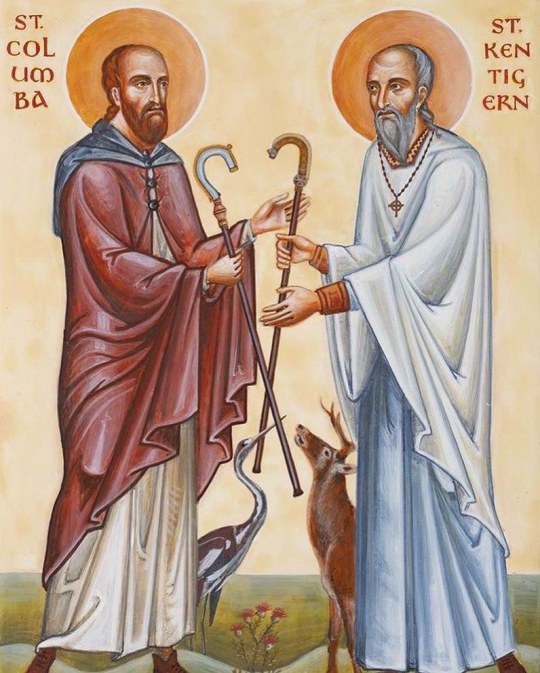
Today we also celebrate our Venerable Father Columba of Iona. Saint Columba was an Irish abbot and missionary evangelist credited with spreading Christianity in what is today Scotland at the start of the Hiberno-Scottish mission. He founded the important abbey on Iona, which became a dominant religious and political institution in the region for centuries. He is the patron saint of Derry. He was highly regarded by both the Gaels of Dál Riata and the Picts, and is remembered today as a Catholic saint and one of the Twelve Apostles of Ireland. Columba studied under some of Ireland's most prominent church figures and founded several monasteries in the country. Around 563 AD he and his twelve companions crossed to Dunaverty near Southend, Argyll, in Kintyre before settling in Iona in Scotland, then part of the Ulster kingdom of Dál Riata, where they founded a new abbey as a base for spreading Celtic Christianity among the pagan Northern Pictish kingdoms. He remained active in Irish politics, though he spent most of the remainder of his life in Scotland. Three surviving early medieval Latin hymns may be attributed to him. May he intercede for us always + Source: https://en.m.wikipedia.org/wiki/Columba (at Island Of Iona, Scotland) https://www.instagram.com/p/CejvrKkPZCc/?igshid=NGJjMDIxMWI=
23 notes
·
View notes